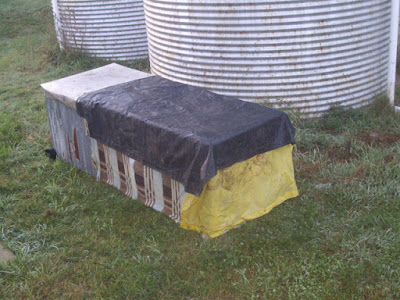The transition from the chicks living in the brooder box to moving into chicken tractors can be difficult. Ideally we hatch the chicks early enough in spring that they can move out after only 6 weeks, before they have all their feathers, because it is usually plenty warm enough by then. Otherwise they have to stay inside longer and once they reach that noisy messy stage I can't wait for them to move out!
Even though it is warm enoug, we find that when we put chicks out in the tractor for the first few nights they need to 'tucked in' at dusk because they are so used to living in a box and not having open sides, its quite scary for them. This means draping tarps, and old sheets, towels and blankets over the tractor so that they feel like they're still in a solid box. Otherwise they spend the night trying to stick their little heads out of the mesh and sometimes they manage to squeeze out! We only have to do this for about a week until they get used to it. This also helps to keep the dew off their grass and keep out any drafts, while they acclimatise to not having the heat lamp above them at night.
We put them in a small tractor at first, and they get used to it moving along, so that when they are in he big tractor they don't get squashed when we move it.
Any tips for moving chicks from the brooder into their outside accomodation? Any questions?
By the way, my chicken tractor ebook is now available if you want to know more about designing and using chicken tractors. More information over at the chicken tractor blog. Or you can get it directly from my shop on Etsy (.pdf format), or Amazon Kindle or just send me an email eight.acres.liz {at} gmail.com.
or just send me an email eight.acres.liz {at} gmail.com.
What's the eBook about?
Chickens in a confined coop can end up living in an unpleasant dust-bowl, but allowing chickens to free-range can result in chickens getting into gardens and expose them to predators.
Even though it is warm enoug, we find that when we put chicks out in the tractor for the first few nights they need to 'tucked in' at dusk because they are so used to living in a box and not having open sides, its quite scary for them. This means draping tarps, and old sheets, towels and blankets over the tractor so that they feel like they're still in a solid box. Otherwise they spend the night trying to stick their little heads out of the mesh and sometimes they manage to squeeze out! We only have to do this for about a week until they get used to it. This also helps to keep the dew off their grass and keep out any drafts, while they acclimatise to not having the heat lamp above them at night.
We put them in a small tractor at first, and they get used to it moving along, so that when they are in he big tractor they don't get squashed when we move it.
 |
| The chicks in their tractor, still tucked in the next morning |
 |
| Morning chicks! |
Any tips for moving chicks from the brooder into their outside accomodation? Any questions?
By the way, my chicken tractor ebook is now available if you want to know more about designing and using chicken tractors. More information over at the chicken tractor blog. Or you can get it directly from my shop on Etsy (.pdf format), or Amazon Kindle
What's the eBook about?
Chickens in a confined coop can end up living in an unpleasant dust-bowl, but allowing chickens to free-range can result in chickens getting into gardens and expose them to predators.
A movable cage or “chicken tractor” is the best of both options – the chickens are safe, have access to clean grass, fresh air and bugs. Feed costs are reduced, chickens are happier, and egg production increases.
But how do you build a chicken tractor? What aspects should be considered in designing and using a chicken tractor effectively? In this eBook I aim to explain how to make a chicken tractor work for you in your environment to meet your goals for keeping chickens.
I also list what I have learnt over 10 years of keeping chickens in tractors of various designs and sizes, from hatching chicks, through to butchering roosters.


Hope they all do OK. We just ordered a good quality canvas tarp to be able to wrap and secure over the end of our chook tractor for Winter. I am sure the chooks would be OK, but it does get chilly down here and the chook tractor's roosting/ nesting area has quite a few gaps. As someone told me, though, our chooks do have their own feather doonas!
ReplyDeleteBless...just look at how small they are :)
ReplyDeleteI think that southern chickens may need some extra protection, ours are ok once they've grown their own doonas! These little ones didn't quite have all their feathers when we first put them out, but apart from that they are like mini-chickens, very cute and addictive to watch!
ReplyDeleteDid Hubby build the little chicken tractor specially for chicks?
ReplyDeleteActually Farmer Pete built it several years ago for our first ever batch of chicks, we now have two small tractors for chicks and three large ones. I've got some posts coming up with more details.
ReplyDelete